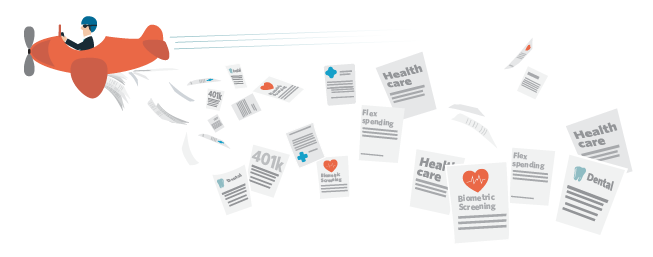
5 Ways to Communicate Employee Benefits to Employees in Multiple Locations

You have an important message to relay to your employees—let’s say it’s the launch of annual enrollment. What’s the best way to ensure that every employee gets the news? If you’re a smaller company, or even a larger company whose employees work at desks within a single office, your task is relatively simple. Sending out a few company-wide emails and posting flyers around the building will likely do the trick.
But that plan of attack probably won’t cut it if a number of your employees work from home, are based internationally, or hold manufacturing or field positions that give them little access to a computer or a consistent physical workspace. It’s the age-old dilemma for HR professionals: How do you connect with those hard-to-reach employees?
Here are five tips we frequently give to our clients for keeping their far-flung folks in the know.
1. Launch a portal.
The foundation for any successful communication strategy is a central information center that every employee (and his or her family) can access quickly and easily. Whether you call it a “portal,” a “benefits hub,” a “website,” or a “microsite,” it’s a critical channel for efficiently reaching disparate audiences. It’s also a great way to promote the idea that you’re helping employees lead better lives, since you’re giving them a reference center where they can find the most up-to-date benefits information, forms, plan documents, and links to key resources.
What we at Benz often create for our clients is a one-stop shop—ideally boasting a descriptive, memorable URL—that can tie related programs together and help organize the messy maze of sites that employees have to toggle between to perform their various tasks, like learning about their medical plan, requesting time off, getting reimbursed through the corporate fitness program, and checking in on their 401(k) account.
The more sites employees have to weed through, the less likely they’ll remember where they need to go the next time a benefits-related matter comes up, and the more likely they’ll contact your HR department for help. A well-organized and frequently updated benefits site makes it easy for employees to remember where to go, and it can seriously stem the flow of questions to your undoubtedly busy HR team and call centers.
To help employees find the information that’s most important to them, consider segmenting the site based on different employee populations. Some possible criteria are life/career stage, job level, and geographical location.
2. Promote the heck out of your site.
There’s a good reason you didn’t see a benefits site pop up in “Field of Dreams.” Just because you build it doesn’t mean they’ll come. Before employees can benefit from all the great information that your site offers, you have to make them aware of 1) the site’s existence and 2) what’s in it for them. And that means marketing it.
For your office employees, you might want to send a series of emails singing the site’s praises: “We’ve made it easy for you to learn about and take advantage of all our great benefits” or “You may miss out on big news if you don’t visit this site at least once a week!” For your workers who aren’t in front of a computer for a big chunk of the workday, you may need to employ more creative tactics to get them to make regular site visits a part of their lives.
One way to spread the word among your non-desk workers is to use short, simple, and attention-grabbing print pieces that promote a specific campaign (e.g., annual enrollment, biometric screenings, flu shots). You can use electronic displays, posters, flyers, table tents, placemats—just be sure to provide a clear and direct call to action that pushes them to the site to learn important details and take next steps. In other words, give them a good reason to go there. And keep providing them with so much useful information that they’ll keep coming back for more.
So, where do you post all these stunning marketing pieces to make the maximum impact? Wherever your employees will see them: locker rooms, break rooms, cafeterias, time card areas, and even corporate shuttle buses. If truck drivers make up a part of your workforce, post the pieces inside their trucks. Just get the message in front of their faces!
When one of our clients wanted to promote a new weight-loss program that was being offered to all employees, we recommended spreading the word via colorful, eye-catching clings placed on every restroom mirror.
Always keep in mind that, in this day and age, you can never underestimate the power of social media. No matter where they work, chances are that most of your employees visit some form of social media site on a regular basis. A simple Facebook ad can go a long way toward promoting your site and directing your employees to the right place for information.
3. Keep it simple.
An essential part of communicating to dispersed work groups is to make your benefits site easy to access and navigate. First and foremost, use a responsive design, which is just a fancy way of saying that employees can easily access the site from their desktop, laptop, or mobile device. Sixty-seven percent of Americans have a smartphone, so a mobile-optimized site is essential. Second, keep the site outside your corporate firewall so that spouses can access it as well. Spouses are often the primary benefits decision-makers, so they need access to information about medical plans and daycare programs as much as employees do.
Some employers shy away from benefits sites living outside the firewall because they want to keep their HR details under wraps. But the advantages of transparency—keeping your workforce informed and engaged being among the most important—far outweigh the risks. If you do have information that needs to be locked down, put it behind the firewall. But the bulk of your benefits information should be available to everyone.
And “keep it simple” isn’t just a great mantra to apply to your benefits portal—it’s an essential philosophy to follow when creating your employee communications. Remember that a lot of stimuli are vying for your employees’ attention, so you need to work hard to make your messages stand out. Using compelling, conversational language helps, but it really all comes down to brevity. What might seem “thorough” to you could easily seem “overwhelming” to a lot of employees. We advise our clients to constantly ask themselves this important question when crafting their communications (and we ask it of ourselves when we’re doing the crafting for them): “What does the employee absolutely need to know?” What doesn’t make the cut in your emails or flyers can always be posted on your benefits website. After all, that’s what it’s there for!
4. Make local managers your messengers.
Those who have direct contact with your non-office employees day in and day out—like local managers and other key influencers—can be your most effective information conveyors. They know how to get the info into the right hands (and eyes and ears) and how to best target the messages to ensure that employees take action. You can provide manager tip sheets or key messages to make sure they have the nuts and bolts, and then leave it to them to tailor the message to their colleagues. They can use whatever forum they think is best, whether it’s their daily team meeting or their weekly newsletter. Or you can do the heavy lifting for them by providing a suite of communication templates. That way, they can easily customize the message to their workforce while still staying on-brand.
Recruiting your local managers not only offers a more fail-proof communication system,it also fosters a more engaging experience for the employees and inspires loyalty in the managers because they feel part of the benefits conversation. These managers can also be a valuable resource in making you aware of communication gaps. They’re in a perfect position to let you know what kinds of questions their teams have and what key issues keep coming up.
5. When in doubt … webinar!
When it comes to giving your employees the information they need to be successful, we’re big proponents of meeting your employees wherever they are. After-hours live webinars or on-demand webinars can be a great way to support employees with alternative working hours—and to include their spouses in the process.
Want additional help reaching your spread-out workforce? Communication is our specialty and we’re always happy to lend a hand. Contact us.
Work with Us
We partner with organizations that value their people first. Let’s talk.

Brian Misso, Senior Writer, is our resident wizard of words, converting dense, complicated information into everyday language that is compelling and easy to understand.
